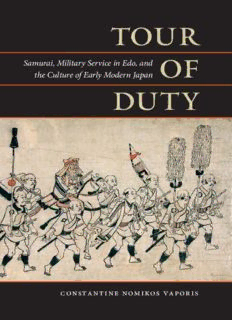
Tour of Duty: Samurai, Military Service in Edo, and the Culture of Early Modern Japan PDF
Preview Tour of Duty: Samurai, Military Service in Edo, and the Culture of Early Modern Japan
(cid:74)(cid:69)(cid:75) (cid:72)(cid:22) Samurai, Military Service in Edo, and (cid:69)(cid:60) the Culture of Early Modern Japan (cid:58)(cid:75) (cid:74) (cid:79) constantine nomikos vaporis (cid:74)(cid:69)(cid:75)(cid:72)(cid:22)(cid:69)(cid:60)(cid:22)(cid:58)(cid:75)(cid:74)(cid:79) (cid:74)(cid:69)(cid:75)(cid:72)(cid:22)(cid:69)(cid:60)(cid:22)(cid:58)(cid:75)(cid:74) (cid:79) Samurai, Military Service in Edo, and the Culture of Early Modern Japan Constantine Nomikos Vaporis university of hawai‘i press | honolulu © 2008 University of Hawai‘i Press All rights reserved Printed in the United States of America 13 12 11 10 09 08 6 5 4 3 2 1 Library of Congress Cataloging-in-Publication Data Vaporis, Constantine Nomikos. Tour of duty : samurai, military service in Edo, and the culture of early modern Japan / Constantine Nomikos Vaporis. p. cm. Includes bibliographical references and index. ISBN 978-0-8248-3205-6 (hardcover : alk. paper) 1. Sankin kotai. 2. Daimyo. 3. Japan — History — Tokugawa period, 1600 – 1868. I. Title. DS871.5.V37 2008 952'.025 — dc22 2008007212 University of Hawai‘i Press books are printed on acid-free paper and meet the guidelines for permanence and durability of the Council on Library Resources. Designed by April Leidig-Higgins Printed by Edwards Brothers For Maria, always Contents Acknowledgments ix Introduction 1 (cid:39) Beginnings 11 (cid:40) The Road to Edo (and Back) 36 (cid:22)(cid:41) The Daimyo Procession 62 (cid:42) Assignment: Edo 102 (cid:43) Daimyo Compounds: Place and Space 128 (cid:44) Life in the Capital 172 (cid:45) Carriers of Culture 205 Conclusion 237 Notes 241 Works Cited 291 Index 313 Acknowledgments This study has required its own form of alternate attendance, with nu- merous changes in residence between Japan and America. During this time I have incurred a proverbial mountain of debt to many people and institutions. A Japan Foundation grant allowed me to make an initial research trip to Japan in 1989–1990 to explore various archives to determine whether there were suf- ficient materials for a monographic study. At that time I made the first of many trips to Kōchi, where I was welcomed warmly by the scholars at the Kōchi Pre- fectural Library. A Travel Grant from the Northeast Asia Council (NEAC) of the Association for Asian Studies and several grants from the Directed Research Ini- tiative Fund (DRIF) at the University of Maryland, Baltimore County (UMBC) allowed me to maintain some momentum on the project while teaching almost year-round. More sustained work was undertaken in Japan under a Fulbright Scholar’s grant in 1993–1994 and from the National Endowment for the Hu- manities (NEH), with additional support from UMBC, in 1997–1998. Additional funding came from the American Philosophical Society, and an NEH Travel-to- Collections grant paid for a visit to the Mitsui Map Collection in Berkeley. An invitation to become a Visiting Scholar at the International Research Center for Japanese Studies (Nichibunken) in 2003–2004 gave me a year in comfort to focus completely on research and writing among a fine community of international scholars. More than a few people pointed out to me the incon- gruity of spending a year in Kyoto to work on a study that has much to do with Edo. Nevertheless, the beautiful foothills of Katsurazaka were a perfect loca- tion to contemplate the movements of the daimyo and their entourages on the highways of Tokugawa Japan. The hikes with family and long-distance runs with friends afforded much opportunity to see the bamboo forests and hidden temples for which Kyoto is justly famous. The final writing and revisions were completed during a semester’s sabbatical leave from UMBC. There are numerous people I would like to thank for their encouragement and support. At UMBC, the former and current chairs of the History Department, John Jeffries and Kriste Lindenmeyer, the latter of whom arranged a subven- tion for some of the images which appear herein. Deans John Jeffries and Scott Bass also jointly provided a generous subvention. While at Nichibunken, the camaraderie and intellectual stimulation provided by many of the other visiting
Description: